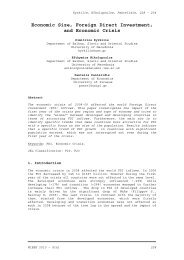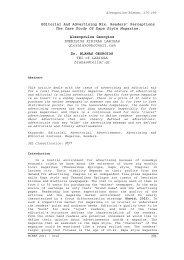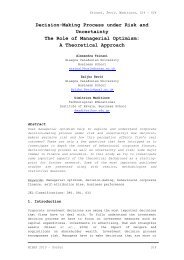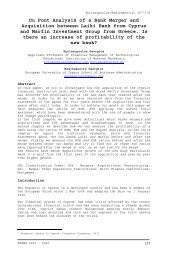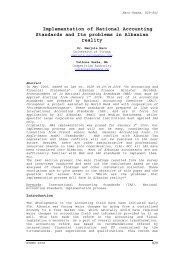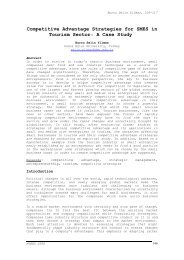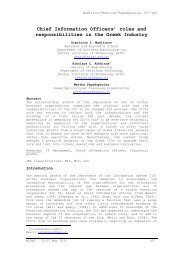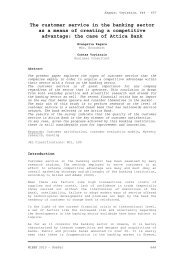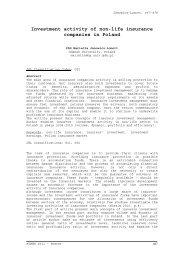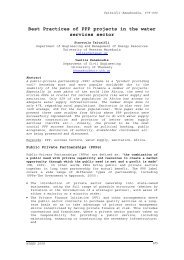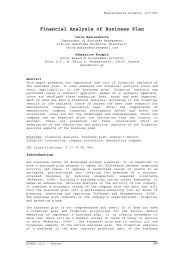The Application of Fundamental Analysis and Technical ... - mibes
The Application of Fundamental Analysis and Technical ... - mibes
The Application of Fundamental Analysis and Technical ... - mibes
Create successful ePaper yourself
Turn your PDF publications into a flip-book with our unique Google optimized e-Paper software.
indexes which derivatives are traded in (Ftse-20, Ftse-40 <strong>and</strong> Eps-50)<br />
from 2001 till 2005 (we do not use 2006 because 6 months statements may<br />
give manipulative results). Regarding daily closing prices, we use the<br />
three above indexes <strong>and</strong> all underlying assets that derivatives (futures<br />
<strong>and</strong> options) come from, for the period 4 August 2003 till 8 August 2006<br />
because during that period ASE recovered from the big downfall coming<br />
from the prices’ explosion in 1999.<br />
<strong>The</strong> methodology is based on Samaras, Matsatsinis <strong>and</strong> Zopunidis (2005).<br />
Specifically, in order to execute the FA, we apply a financial analysis<br />
<strong>of</strong> listed companies through the financial ratios method. As mentioned<br />
above, in order to execute FA <strong>and</strong> TA for derivatives, it is essential<br />
to apply the FA <strong>and</strong> TA to the underlying asset. So, listed companies in<br />
the three indexes (Ftse-20, Ftse-40 <strong>and</strong> Eps-50) are divided into three<br />
categories according to their main business, banks, industrial <strong>and</strong><br />
insurance companies. <strong>The</strong> appropriate financial ratios for each company<br />
are created in order to classify the firms into three categories by<br />
their performance: good, fair <strong>and</strong> not good. This classification arises<br />
from the calculation <strong>of</strong> the 18 ratios <strong>and</strong> their ranking in 0 for not<br />
available, 1 for bad, 2 for fair <strong>and</strong> 3 for good. So aggregating the<br />
ranking <strong>of</strong> all ratios, firms are classified in the above three<br />
categories.<br />
TA is based upon the daily closing prices <strong>of</strong> the above three indexes<br />
<strong>and</strong> the stocks on which derivatives’ products has been created. Using<br />
the appropriate s<strong>of</strong>tware (Metastock Pr<strong>of</strong>essional 9.0), we calculate 3<br />
ratios (trade efficiency, Risk Reward ratio <strong>and</strong> Pr<strong>of</strong>it Loss ratio) <strong>and</strong><br />
we classify these ratios in three ranks, 0 for bad (negative returns),<br />
1 for fair (0%-50% returns) <strong>and</strong> 2 for good (50%-100% returns). So<br />
aggregating these three ratios, we calculate each stock’s performance,<br />
which is divided into three classes, bad, fair <strong>and</strong> good.<br />
<strong>The</strong> results <strong>of</strong> FA <strong>and</strong> TA are connected with SEC, IND, SIZ, EST <strong>and</strong> IMP<br />
in order to conclude whether the performance is correlated with each <strong>of</strong><br />
these factors or not. Finally, the results will be based on the<br />
underlying market but the application to derivatives is efficient<br />
because these two markets follow the same trend, upward or downward.<br />
Financial Ratios<br />
<strong>The</strong> FA is based on the calculation <strong>and</strong> the evaluation <strong>of</strong> financial<br />
ratios. <strong>The</strong>y provide analysts with elements about the efficiency <strong>and</strong><br />
the performance <strong>of</strong> a company or even specific sectors <strong>of</strong> a firm. But<br />
ratios on their own, are just numbers <strong>and</strong> only by comparing them with<br />
ratios <strong>of</strong> past years or with ratios <strong>of</strong> other departmental firms, can<br />
someone underst<strong>and</strong> their significance (Niarchos, 1989, p.215).<br />
According to Ming (1984), in order to draw a clear view <strong>of</strong> a firm’s<br />
performance, there should be calculated five different kinds <strong>of</strong> ratios,<br />
efficiency, pr<strong>of</strong>itability, liquidity, gearing <strong>and</strong> investment. <strong>The</strong> most<br />
common used ratios are illustrated in table 1 (see appendix).<br />
While table 1 contains ratios for the industrial companies, table 2<br />
(see appendix), presents banking ratios which differentiate from the<br />
others because all their financial statements are based on the banking<br />
accounting plan. In the banking balance sheet major role play the<br />
savings which belong to the claims. <strong>The</strong>se savings are used by the banks



